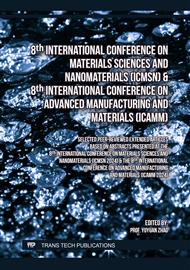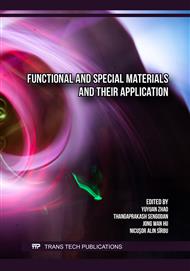[1]
Dahman Y, Lo HH, Edney M, in Nanotechnology and Functional Materials for Engineers, ed. by Yaser Dahman ( Elsevier, Amstedam, Netherlands, 2017), p.1 .
DOI: 10.1016/b978-0-323-51256-5.00001-0
Google Scholar
[2]
J. Jeevanandam, A Sundaramurthy, V.Sharma, C.Murugan, K.Pal, M.Kodous, M.Danquah, in Sustainable Nanoscale Engineering, ed. by Gyorgy Szekely, Andrew Livingston (Elsevier Inc., 2019) p.83.
DOI: 10.1016/b978-0-12-814681-1.00004-7
Google Scholar
[3]
Michael Smith & Sohini Kar-Narayan, Piezoelectric polymers: theory, challenges and opportunities. International Materials Reviews 67, 65 (2022).
DOI: 10.1080/09506608.2021.1915935
Google Scholar
[4]
Z. He, F. Rault, M. Lewandowski, E. Mohsenzadeh, and F. Salaün, "Electrospun PVDF nanofibers for piezoelectric applications: A review of the influence of electrospinning parameters on the β phase and crystallinity enhancement," Polymers (Basel) 13, 2, 1 (2021).
DOI: 10.3390/polym13020174
Google Scholar
[5]
Sappati K.K. Bhadra. S, Piezoelectric Polymer and Paper Substrates: A Review. Sensors 18, 3605 (2018).
DOI: 10.3390/s18113605
Google Scholar
[6]
Wu, Liangke & Jin, Zhaonan & Liu, Yaolu & Ning, Huiming & Liu, Xuyang & Alamusi, & Hu, Ning. Recent advances in the preparation of PVDF-based piezoelectric materials. Nanotechnology Reviews. 11, 1386 (2022).
DOI: 10.1515/ntrev-2022-0082
Google Scholar
[7]
F. Calavalle, M. Zaccaria, G. Selleri, T. Cramer, D. Fabiani, and B. Fraboni. Piezoelectric and Electrostatic Properties of Electrospun PVDF-TrFE Nanofibers and their Role in Electromechanical Transduction in Nanogenerators and Strain Sensors. Macromol Mater Eng. 305, 7 (2020).
DOI: 10.1002/mame.202000162
Google Scholar
[8]
Tongtong Zhang, Tao Yang, Mei Zhang, Chris R. Bowen, Ya Yang. Recent Progress in Hybridized Nanogenerators for Energy Scavenging. iScience 23, 11 (2020).
DOI: 10.1016/j.isci.2020.101689
Google Scholar
[9]
I. Alghoraibi and S. Alomari. Different Methods for Nanofiber Design and Fabrication in Handbook of Nanofibers, Springer International Publishing 1 (2018).
DOI: 10.1007/978-3-319-42789-8_11-2
Google Scholar
[10]
L. Xu, F. Liu, Y. Wan, D. D. Ganji, and N. Faraz. Fabrication and applications of electrospun nanofibers. Journal of Nanomaterials, Hindawi Publishing Corporation 1(2015).
DOI: 10.1155/2015/697236
Google Scholar
[11]
L. Ruan, X. Yao, Y. Chang, L. Zhou, G. Qin, and X. Zhang. Properties and applications of the β phase poly(vinylidene fluoride)," Polymers (Basel) 10, 3,1 (2018).
DOI: 10.3390/polym10030228
Google Scholar
[12]
R. P. Vijayakumar, D. V. Khakhar, and A. Misra. Studies on α to β phase transformations in mechanically deformed PVDF films. J Appl Polym Sci. 117, 6, 3491 (2010).
DOI: 10.1002/app.32218
Google Scholar
[13]
S. Tiwari, A. Gaur, C. Kumar, and P. Maiti, Enhanced piezoelectric response in nanoclay induced electrospun PVDF nanofibers for energy harvesting. Energy 171, 485 (2019).
DOI: 10.1016/j.energy.2019.01.043
Google Scholar
[14]
N. Shehata, R. Nair, R. Boualayan, I. Kandas, A. Masrani, E. Elnabawy, N. Omran, M. Gamal, and A. H. Hassanin. Stretchable nanofibers of polyvinylidenefluoride (PVDF)/thermoplastic polyurethane (TPU) nanocomposite to support piezoelectric response via mechanical elasticity. Scientific Reports 12, 1(2022).
DOI: 10.1038/s41598-022-11465-5
Google Scholar
[15]
M. Satthiyaraju and T. Ramesh. Effect of annealing treatment on PVDF nanofibers for mechanical energy harvesting applications. Mater Res Express 6, 10 (2019).
DOI: 10.1088/2053-1591/ab4037
Google Scholar



